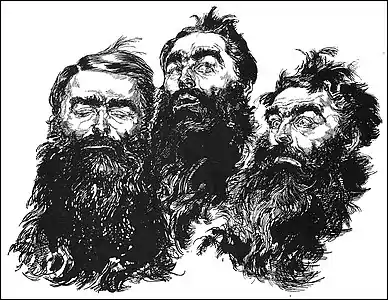Joseph Clement Coll
Joseph Clement Coll (July 2, 1881 – October 19, 1921) was an American book and newspaper illustrator. He was known for his pen and ink story illustrations that were used to illustrate adventure stories such as Conan Doyle's Sir Nigel.[2]
Joseph Clement Coll | |
|---|---|
| Born | July 2, 1881[1] |
| Died | October 19, 1921 (aged 40)[1] |
| Nationality | American |
| Known for | Pen and ink illustration |
Early life
Joseph Clement Coll was born on July 2, 1881, in Philadelphia to an Irish immigrant family.[3][4] Both his father and his brothers worked as book binders. As a child, Coll read many illustrated books and magazines. He graduated Central High School, where he took basic art courses, and started work without any academic art training.[3][4]
Illustration career
Joseph Clement Coll began his professional career working for the New York American as a newspaper artist apprentice at age 17.[5] At this time, his position would be similar to a modern-day news photographer, as his job was to illustrate current events each day within the daily deadline. That same year, he moved to Chicago temporarily. In 1901, he came back to Philadelphia to work on The North American and soon drew the eye of his editor, J. Thomson Willing, who sent him on special missions to procure his skill.[5] The two remained friends even after Coll stopped doing newspaper illustrations.[5] He was soon working for magazines such as Collier's, Everybody's and the American Sunday Magazine. Coll's reputation stands mainly on his pen & ink story illustrations.
In contrast to most illustrators who worked in pen & ink, Coll achieved true tonal gradations in his illustrations by using pen strokes to build up a complete range of values. He was influenced by the Spanish pen & ink artist Daniel Vierge. According to Walt Reed, Coll's "technical virtuosity nor the romantic fantasy of his point of view has ever been rivaled".[5]
Coll was also a painter and he often did paintings for the cover or frontispiece of books which were reproduced in color and then pen & inks to illustrate the text. He was considered to be an ideal illustrator for authors such as Arthur Conan Doyle and other adventure writers.[6] His illustrations for books such as Talbot Mundy's King of the Khyber Rifles and Sax Rohmer's The Insidious Dr. Fu Manchu were widely reprinted for many years. Coll died in 1921 of appendicitis, aged 40.[5]
Technique
Before Coll started an illustration, he would contemplate on the design of the composition for a long while, which allowed him to draw without a model.[5] Later in his career, when he was able to use a model, he would draw a shaded image of the model with pencils on tracing paper, after which he would darken the backs of the tracing paper and retrace onto bristol board or illustration board.[7] He would do the same earlier in his career but used his inner vision instead of model. He then would start the final ink drawing, for which he used fountain pens.[7]
Gallery
 Professor Challenger, before 1921, ink on paper
Professor Challenger, before 1921, ink on paper Doctor Fu Manchu, 1910s, ink on paper
Doctor Fu Manchu, 1910s, ink on paper Illustration for The Story "The Tillotson Banquet", 1921, ink on paper
Illustration for The Story "The Tillotson Banquet", 1921, ink on paper
References
- Walt Reed, America's Great Illustrators, Abbeville Press, 1979, p. 36
- John Fleskes, ed., "Joseph Clement Coll: The Art of Adventure", Flesk Publications, 2003
- Dictionary of Literary Biography (Gale Publications).
- John Fleskes, ed., Joseph Clement Coll: The Art of Adventure, Flesk Publications, 2003
- "Joseph Clement Coll - Illustration History". www.illustrationhistory.org. Retrieved 2021-10-13.
- "Joseph Clement Coll | American Illustration | The Korshak Collection". korshak. Retrieved 2021-10-13.
- Reed, Walt (1978). The Magic Pen of Joseph Clement Coll. New York: North Light Publishers. pp. 11, 12. ISBN 9780891340096.
- See Walt Reed, America's Great Illustrators, Abbeville Press, 1979, p. 36 for context in Coll's standing in the illustration field.
- Reed, Walt (1978). The Magic Pen of Joseph Clement Coll. New York: North Light Publishers. pp. 169–176. ISBN 9780891340096.
External links
- Works by or about Joseph Clement Coll at Internet Archive
- Joseph Clement Coll at the Internet Speculative Fiction Database
- Biography by Jim Vadeboncoeur
- Joseph Clement Coll at Library of Congress, with 9 library catalog records